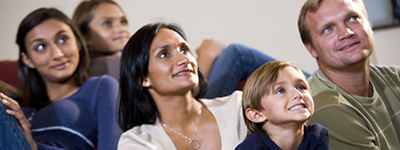
In fall and spring a ritual takes place among millions of 14-24 year olds that has nothing to do with school. For one hour every Thursday night they tune in to watch a group of castaways that have been left on an uninhabited island far away. They watch these ordinary people on Survivor form alliances against one another, compete for food and fire, and battle against nature in what has been dubbed “Reality TV.” But how real is it?
The form of TV started by Alan Funt in 1948 as a way to laugh at the everyday situations we find ourselves no longer looks anything like the original family fare, Candid Camera. Reality TV has morphed beyond mere humorous snapshots of life into voyeuristic short films where the cameras never stops running. Comedy has been replaced with self deprecation and humiliation absent of any shame.
In 2007, for the first time, a Reality TV show, The Hills, starring former Laguna Beach beauty Lauren Conrad, was the highest rated show on basic cable among older teens. Other network reality shows like Big Brother, Amazing Race, and The Bachelor continue to win their time slots as well. It is undeniably the fastest growing genre on TV with more than 400 different shows created in the past ten years. But is it possible that Reality TV is nothing more than contrived scenarios created for ordinary people in order to make a ton of money for studios with little concerns for standards?
A Cut and Paste Real World
In 1992 with the creation of The Real World, MTV started a revolution in TV programming that continues nineteen seasons later. For the first time teenagers could take a peek into the lives of singles and see what “real life” is like for young adults. The people and situations are real, just not how it all unfolds. What is billed as reality is nothing more than hundreds of hours of footage that has been pieced together to create a believable story line.
The typical show like The Real World or Big Brother can take up to six days of shooting for one thirty minute segment. The cameras are rolling nonstop but there isn’t much to see. Reality TV writer David Rupel said, “Trust me, as someone who has literally watched tens of thousands of hours of raw footage, nobody is interesting all of the time. If you watch every second of someone’s life, the majority of it is boring.” When there is nothing compelling happening, the writers (yes reality shows have writers) create tension and conflict by forcing the participants into conversations or group projects.
The inevitable fights and confrontations are advertised as “unexpected twists” in the show. During one season of Survivor as the two tribes got smaller they didn’t merge into one as we, the viewers, thought they would. This was a “surprising new twist” in the drama. In reality it was scripted by the producers that they couldn’t. We just weren’t in on the twist.
So what appears as a major fight or “making out” sequence on camera probably never happened that way. It’s also the reason why reality contestants aren’t allowed to get drastic haircuts during the filming. It might mess up the producers ability to fabricate reality with splicing film.
This has huge implications for teens, the biggest watchers of Reality TV. It’s easy to watch Jersey Shore or America” Next Top Model and assume that this is what life is supposed to be like. This is the fun, spontaneity, and romance they are missing out on and somehow need to manufacture in their own lives. It is our role as parents to peal back the facade of TV so they can see the value in the life they have been given.
The Downward Spiral
A recent poll by the Associated Press revealed that 62% of Americans believe TV is getting worse with 85% of evangelicals having the same feelings. 75% of all people also feel there is too many reality programs. The ubiquity of reality shows has changed the landscape of TV in more ways than one. A 2002 study by the PTC revealed that among all reality shows on network television there was an average of 9.5 instances of sexual references, violence, or foul language by hour. Among reality shows on basic cable it was three times the amount at 29.4 instances by hour. Translation: There is more depravity on reality shows than any other kind of programming. Reality shows are now the pace setters for the rest of broadcasting.
Just take MTV’s biggest reality show The Real World for example. It has given us such memorable scenes as girl on girl sexual experimentation, multi-partner make out sessions, and drunken couples engaging in sex, blacking out, and joking the next day about not remembering anything that happened. It has become the new sex ed for teens.
Dating shows have come along way as well. Instead of The Dating Game of the 70’s, we the demoralizing Dismissed from MTV. In each episode a guy gone on an intimate date with two girls then “dismisses” one after the fun. This past fall they also aired the first bisexual dating show, A Shot at Love, starring Tila Tequila. Sixteen men and women compete for the affections of the self-professed bisexual MySpace star as she eliminates one potential mate each week.
“It’s the Real Thing” for Advertisers
Reality programs are a financial windfall for television studios costing them, many times, less than 25% of what a traditional program cost to create. Even with the minimal costs they have found deceptive ways to milk even more money from this genre.
Most reality programs include what is called product placement. It’s a clever way for advertisers to promote their products as if they are naturally appearing in the lives of the participants. Surely you’ve noticed the ever-present Coke® glasses on the judge’s table of American Idol or how the Extreme Makeover: Home Edition cast shops at Sears each week. It’s not so much reality as it is creating an illusion of popularity—this is what all the cool people drive, listen to, or drink. Advertisers know your teen spends an average of $46 per week and are going to find a way to get to it.
Redeeming Reality
Not all reality TV is about sex and deception. Some recent shows that have been a rating bonanza in the reality category are Extreme Makeover: Home Edition, The Amazing Race, and The Biggest Loser. All three of these are popular among teens (especially tweens) and show redeeming values of importance of family, personal responsibility, overcoming trials, and resolving conflicts.
While still not completely real, watching these shows (and others that will come) can give you an opportunity to talk with your teen about how to handle pressure and how to make choices that honor themselves and others, as well as harder subjects like delayed gratification and sacrifice.
If Reality TV is going to be one of your teen’s viewing choices then here are a few tips on how to increase your chances of it being a positive experience.
1. Watch Together. If your teen feels uncomfortable watching with you, chances are its something that shouldn’t be watched at all.
2. Talk. Talk. Talk. Debrief after the show to talk about healthy real-life responses to situations they might encounter. Ask open-ended questions to hear your teen’s point of view.
3. Be Biblically Relevant. Help your teen see how God’s word can apply to the situations you are watching. That doesn’t mean you have to make every situation on TV into a “Jesus moment” but when there is an obvious life lesson, take advantage of it.
4. Model Reality. Don’t let the worldview of Reality TV be the dominant voice in their lives. Model for your teen what a healthy marriage, communications, and friendships look like.
5. Set Limits. Any media has to be used in moderations. Many reality shows are filled with sexual content, dysfunctional relationships, and distrust. Too much of this can skew our own thinking. An all day Saturday marathon of 16 and Pregnant is probably not a good idea.
http://www.usatoday.com/life/television/news/2007-09-05-nielsens-analysis_N.htm
www.tv.com.
David Rupel, How Reality TV Works. www.wga.org.
http://icrsurvey.com/Study.aspx?f=Teen_Survey_0805.html
J. Bateman, Reality Television Programs Broadcasting Unreal Amounts of Inappropriate Content. www.ptc.org/library/rtvcontent.htm.


